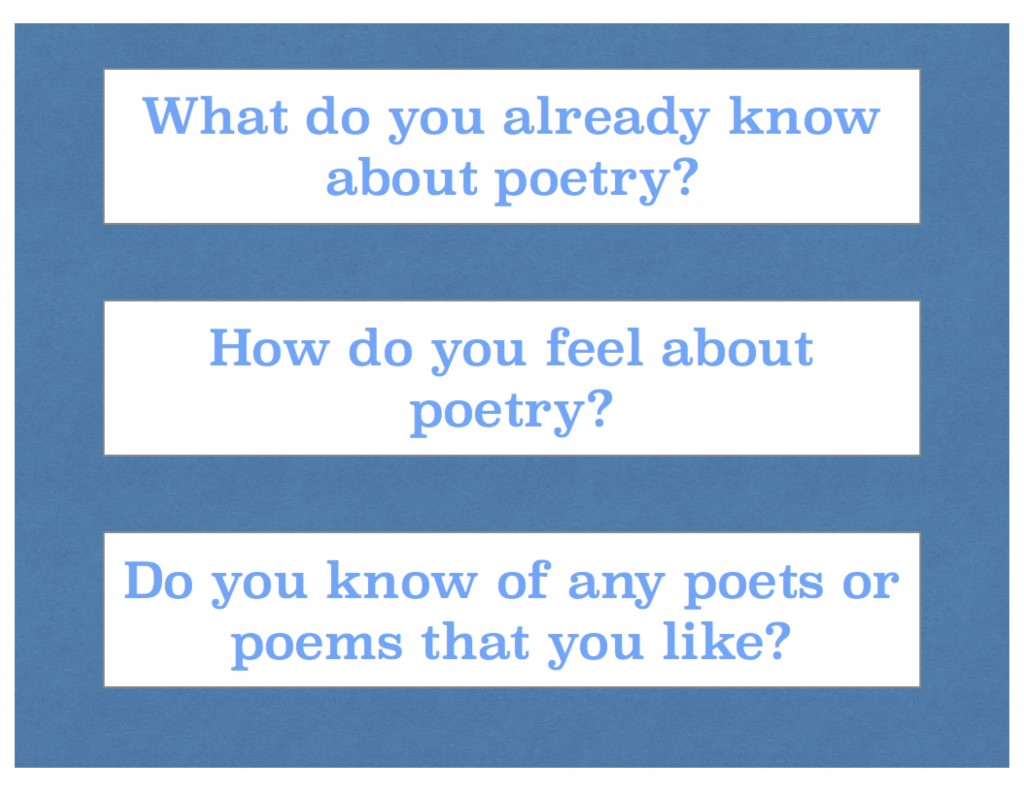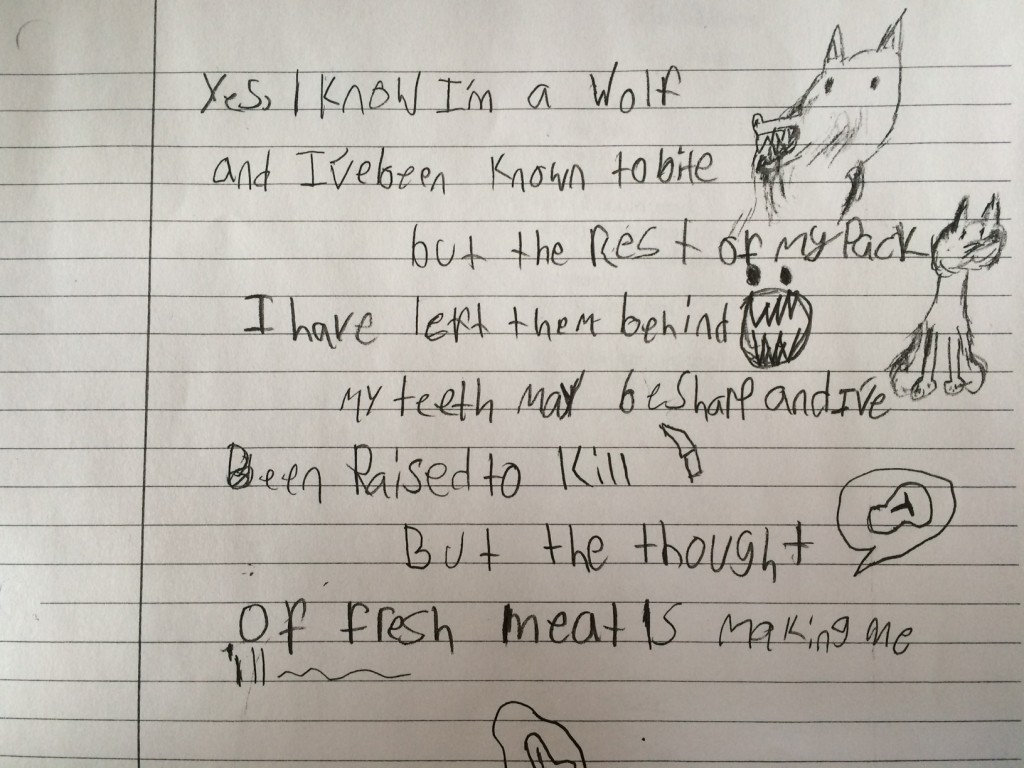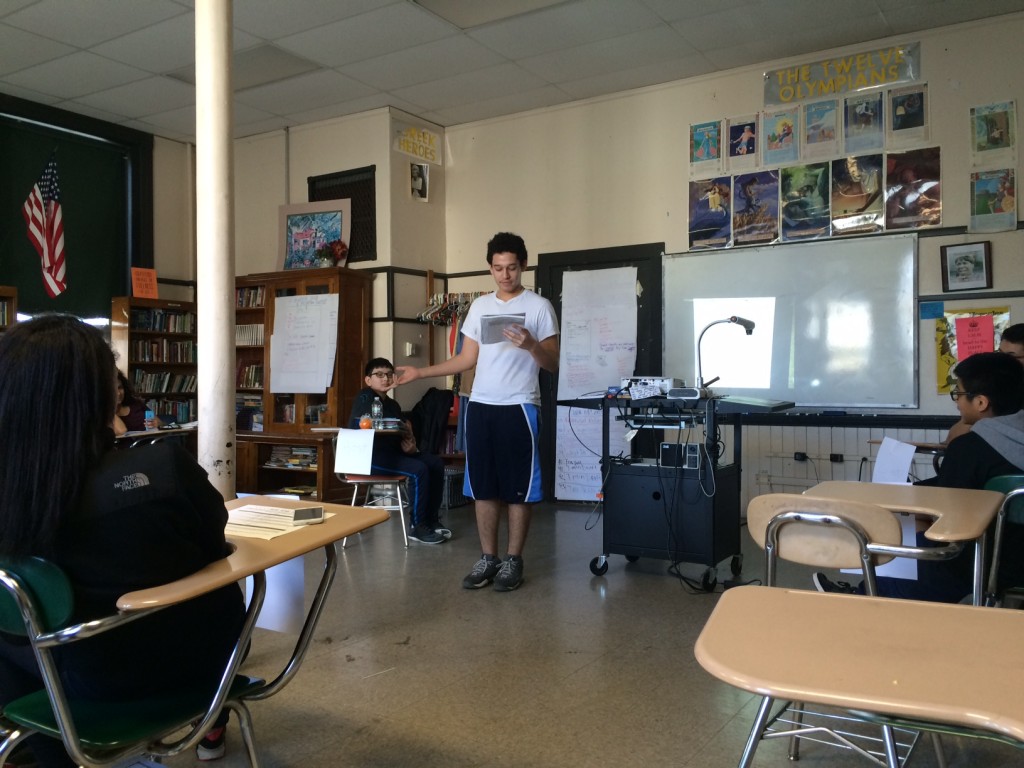Lesson Activity # 1 – Introducing Poetry
 To start of the unit, I wanted to know what my students knew about poetry so far and how they felt about it. I anticipated that there would be some mixed feelings about poetry, but I wasn’t sure what to expect. To gather up this data (and structure a class discussion), the students spent time answering three questions about poetry—what they already know about poetry, how they feel about poetry, and what poets or poems that they might already know about. Once they answered these questions, the students taped their answers up on the board, and spent some time just looking at the “wallpapered” board and writing down in their own notebooks their reactions and things that they learned from their classmates responses. After this activity, their homework was to bring in a copy of their favorite poem or the lyrics to their favorite song. This led into a short in-class writing assignment in the next class that asked them to compare a poem we read together with the poems that they brought in.
To start of the unit, I wanted to know what my students knew about poetry so far and how they felt about it. I anticipated that there would be some mixed feelings about poetry, but I wasn’t sure what to expect. To gather up this data (and structure a class discussion), the students spent time answering three questions about poetry—what they already know about poetry, how they feel about poetry, and what poets or poems that they might already know about. Once they answered these questions, the students taped their answers up on the board, and spent some time just looking at the “wallpapered” board and writing down in their own notebooks their reactions and things that they learned from their classmates responses. After this activity, their homework was to bring in a copy of their favorite poem or the lyrics to their favorite song. This led into a short in-class writing assignment in the next class that asked them to compare a poem we read together with the poems that they brought in.
Lesson Activity #2 – Figurative Language Activity
For this class, the students broke into groups of 4 and 5. I set up multiple stations around the room, with examples of different types of figurative language at each one. Station 1 was simile, so students were given an example of a simile, and then asked to come up with 5 more examples of similes on their own. After a few minutes at each station, they rotated, and went on to the next station where they were given a different type of figurative language to focus on. For the most part, all students were engaged in this activity, and they enjoyed being able to come up with their own examples, especially when they could include silly examples about each other. Later on, when we discussed examples of figurative language in poems that we read and in their own poems, students called back on this activity to remember what different types of figurative language were. For examples of their work from this activity, please see the corresponding section under Student Work Samples.
Lesson Activity #3 – Different Forms of Poetry
After reviewing figurative language, we spent quite a bit of time learning about different forms of poetry. I decided to focus on six different forms: haiku, ballad, ode, sonnet, concrete poetry, and free verse. When I first structured this lesson, students were bored and not engaged. It was dumping information at them about different forms, and having them take notes for most of the class. I knew that this wasn’t working out, so I decided to change the way I taught the different forms. I started out by showing them examples of different poems, having them think of what each example had in common, asking them, “what do you notice?” and then at the end revealing what the name of the form was. This format kept them engaged for a little while more, but by the time we got to Free Verse, which was the last form I taught, once again they were bored and disengaged. Though my original plan (attached) was to teach Free Verse in the same “what do you notice?” way, I decided to just get them writing. I basically threw out my original plan, and had the students write what they thought a Free Verse poem would be. After this, we looked at some free verse examples, determined what goes into a free verse poem, and then the students revised their free verse drafts in class. This led well into the next activity, which was to have the students write a series of 7-minute poetry drafts in the different forms that they learned about.
Lesson Activity #4 – Writing Poetry Drafts
Because I was thinking forward to having the students get ready to put their poetry anthology together, I wanted to get them to start writing as many different drafts of poetry as they could. This way, when they began the revision process, they would be able to choose from all of the drafts that they had written. We spent a whole class writing a series of 7-minute poetry drafts. For each draft, the students had to pick a different form that they had learned about. Most students chose free verse, but many were also interested in odes, haiku, and concrete poetry. An adventurous few even tried their hands at some sonnets. Eventually, after choosing their favorite drafts for revision, students picked the final poem that would go into their anthology page. We did some peer-editing activities, and then transitioned into the process of putting together their pages for publication. This process was rough, and took longer than I anticipated, but by the end, every single student turned in a poem on an anthology page.
Lesson Activity #5 – From the Page, to the Stage
Once the Anthologies were finished and being printed up, we transitioned into a mini-unit-within-a-unit focusing on spoken word poetry performances. Specifically, we focused on the question, “how does a poet’s performance of a poem affect the poem’s meaning?” In this particular lesson activity, after we looked at different video examples of spoken word poetry, I read e.e. cummings’ “[i carry your heart with me(i carry it in]” to the class in the most monotone, boring performance I could possibly do. The students were very eager to tell me why my performance was so bad, mentioning that it seemed as if my mother had forced me to read the poem when I really didn’t want to. This showed me that the students’ had at least some idea of what a good performance would be. They recalled their experiences performing in A Midsummer Nights’ Dream, and gave me a lot of advice for how to improve my performance. Though I had originally planned on doing a second reading that was much more animated, I decided to have the students volunteer to do a better reading instead, which kept them more engaged, and gave them some practice for their own performances. After this lesson, we prepared for our poetry slam and open mic, where each student was asked to perform the poem they wrote in the anthology in either a competitive or non-competitive setting. This wrapped our unit up, and helped us to end a long and rocky unit on a fun note.


